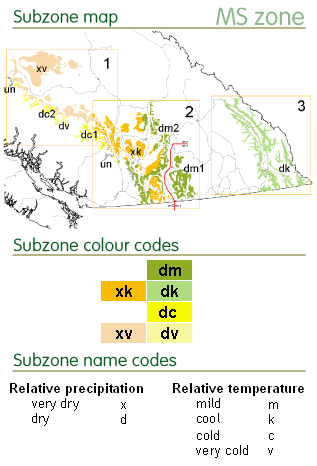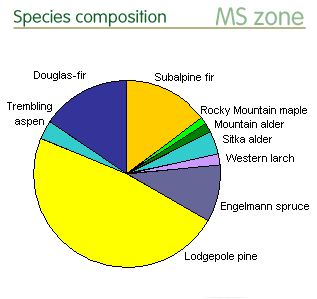Montane Spruce Zone
General description
The MS is a small montane zone that covers only 2.9% of the province. It occurs on the high plateaus in central and southern interior BC, on the leeside of the Coast and Cascade Mountains, on the southern Rocky Mountains, and in the Rocky Mountain trench.
The MS zone occupies a narrow elevational band situated below the subalpine ESSF and above the IDF and SBPS zones. It has a continental climate with cold winters and short (2-4 month), dry, and warm summers. It was originally treated as the drier and warmer, low-elevation portion of the ESSF zone but today is considered a separate zone, transitional between the ESSF and the IDF zones.
Mean annual temperatures range from around 0°C in the northern and western subzones around the Chilcotin and the Coast and Cascade Mountains to around 3°C in the lower elevation subzones around Kamloops and Kelowna. Summer precipitation is lowest in the central western subzones in the lee of the Coast and Cascade Mountains (200-215mm) and highest in the far east near the Rocky Mountains (270mm).
View detailed subzone maps and climate data for the MS zone.
Forest description
 Lodgepole, the major species in the zone, forms extensive even-aged stands following fire. Englemann spruce and subalpine fir, longer lived species characteristic of the ESSF zone, mostly occur only as a minor components in the canopy of older lodgepole pine stands on wetter sites and/or in the wetter subzones; on cool-aspect or seepage sites they become more prevalent.
Lodgepole, the major species in the zone, forms extensive even-aged stands following fire. Englemann spruce and subalpine fir, longer lived species characteristic of the ESSF zone, mostly occur only as a minor components in the canopy of older lodgepole pine stands on wetter sites and/or in the wetter subzones; on cool-aspect or seepage sites they become more prevalent.
The presence of other species varies greatly by subzone. Tree species diversity is lowest in the cool, dry MSdv (mainly lodgepole pine and subalpine fir) and highest in the wetter and milder MSdk subzone. Douglas-fir and trembling aspen, common in the southern subzones, reach their highest proportions in the MSdk. Western larch, Rocky mountain maple, paper birch and western redcedar, are also prevelant in the MSdk.
To see how species composition in the MS zone varies with climate, view species by subzone pie charts.
Conservation status
Protected areas
There are just over 60 protected areas in the MS zone, half of them larger than > 250 ha. On average, protected areas cover 8% of the land but coverage varies greatly from 26% in the MSdc/dv/un to < 2% in the MSdm1, which only has two large protected areas and a high proportion (70%) of young forests.
- View protected area distribution on the subzone maps and the protected area and land use statistics for the subzone/variants of the MS zone.
Species representation in protected areas
The common species in the MS zone have adequate protected area representation but generally < 10% of their cumulative cover is protected. There are ten infrequent species with low protected area representation. Most of the conservation shortfalls are not of concern in terms of genetic conservation as the species are considered transitional in the MS zone.
Western redcedar, Pacific yew, and western white pine have wide, disjunct distributions across southern BC, mainly in mesothermal and cool temperate climates where they are common and well protected. Less than 2% of their range occurs in the warmer and wetter MS subzones bordering the ICH and they are not considered important species in the MS zone in terms of in situ conservation. For western white pine, increasing active management (selection, breeding, deployment of disease resistant trees), rather than passive in situ conservation, may be a better long-term strategy. Whitebark pine, more characteristic of wetter, higher-elevation AT and ESSF zones may also benefit more from increased active management and ex situ conservation efforts.
Rocky Mountain juniper and pondersa pine occur more frequently in the cool temperate or semiarid climates of the IDF or PP zones, respectively, than in the drier MS subzones. Several large protected areas spanning the MS and IDF zone (Cathedral, Okanagan Mountain, Myra–Bellevue, Trepanier, and Kootenay) will likely provide adequate protection should either species increase with climate warming.
Choke cherry, water birch, sitka willow and pussy willow are wide-ranging species in BC. The first three have a small portion of their range in the MS and are either well protected, or recommended for field verification in other zones (e.g. it is recommended that conservation efforts for water birch be directed at verification in the IDFxh2 and dm2, or at the northern part of its range in the BWBS zone). In contrast, pussy willow has a higher proportion of its range in the MS zone (8%) and is potentially under-protected in many adjoining zones (IDF, ESSF, ICH zones together containing 35 % of its range). As such, it is identified as a species of concern and its protected area populations in the MS zone could be of importance for genetic conservation.
Limber pine is known to occur in southeastern BC. While there are no location records for limber pine in the MS zone in the data set, it is considered to be a species of importance in MS zone as protection levels are low in the adjoining IDF and ESSF zones.
- See “BC Tree Species Reports” webpages to view tree species range maps with protected areas, or range maps with conservation statistics by BGC zones.
Conservation priorities
Field verification of protected area populations is recommended for pussy willow in the multi-zone protected areas in the south and east that span the IDF, ESSF, or ICH zones. Limber pine is recommended for field verification in the Rocky Mountain Trench.
References
The general ecology information presented here has been summarized from the BC MOF brochure on the BWBS zone and the BC MOF publication Meidinger, D. and J. Pojar. 1991. Ecosystems of British Columbia. BC Ministry of Forests, Victoria, BC. 330pp.
The in situ conservation statisitics are from Hamann, A., Smets, P., Aitken, S. N. and Yanchuk, A. D. 2005. An ecogeographic framework for in situ conservation of forest trees in British Columbia. Can. J. For. Res. 35:2553-2561. View online resources.
The in situ conservation status summaries are from C. Chourmouzis, A.D. Yanchuk, A. Hamann, P. Smets, and S.N. Aitken. 2009. Forest Tree Genetic Conservation Status Report 1: In situ conservation status of all indigenous BC species. Centre for Forest Conservation Genetics, Forest Genetics Council of BC, and BC Ministry of Forests and Range, Forest Science Program, Victoria, BC Technical Report 053. www.for.gov.bc.ca/hfd/pubs/Docs/Tr/Tr053.htm. View online resources.
